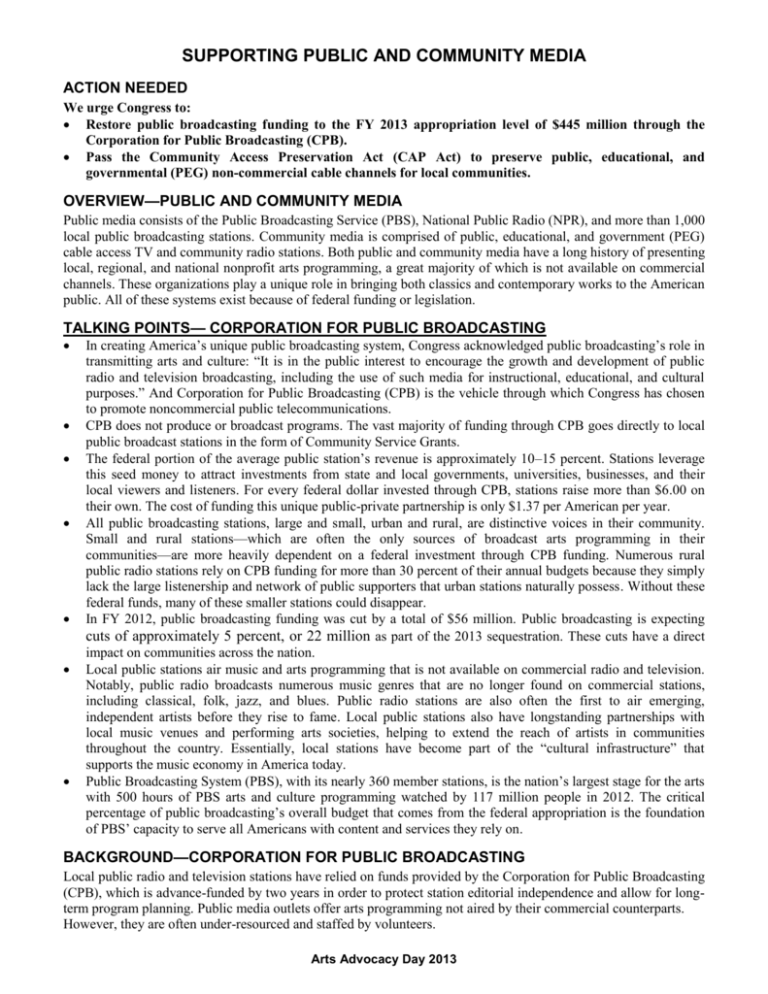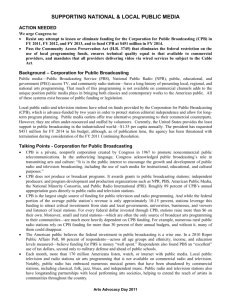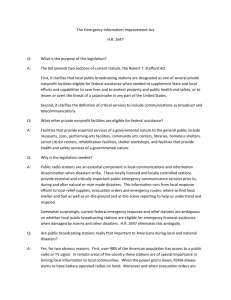Overview—Public and Community Media
advertisement

SUPPORTING PUBLIC AND COMMUNITY MEDIA ACTION NEEDED We urge Congress to: Restore public broadcasting funding to the FY 2013 appropriation level of $445 million through the Corporation for Public Broadcasting (CPB). Pass the Community Access Preservation Act (CAP Act) to preserve public, educational, and governmental (PEG) non-commercial cable channels for local communities. OVERVIEW—PUBLIC AND COMMUNITY MEDIA Public media consists of the Public Broadcasting Service (PBS), National Public Radio (NPR), and more than 1,000 local public broadcasting stations. Community media is comprised of public, educational, and government (PEG) cable access TV and community radio stations. Both public and community media have a long history of presenting local, regional, and national nonprofit arts programming, a great majority of which is not available on commercial channels. These organizations play a unique role in bringing both classics and contemporary works to the American public. All of these systems exist because of federal funding or legislation. TALKING POINTS— CORPORATION FOR PUBLIC BROADCASTING In creating America’s unique public broadcasting system, Congress acknowledged public broadcasting’s role in transmitting arts and culture: “It is in the public interest to encourage the growth and development of public radio and television broadcasting, including the use of such media for instructional, educational, and cultural purposes.” And Corporation for Public Broadcasting (CPB) is the vehicle through which Congress has chosen to promote noncommercial public telecommunications. CPB does not produce or broadcast programs. The vast majority of funding through CPB goes directly to local public broadcast stations in the form of Community Service Grants. The federal portion of the average public station’s revenue is approximately 10–15 percent. Stations leverage this seed money to attract investments from state and local governments, universities, businesses, and their local viewers and listeners. For every federal dollar invested through CPB, stations raise more than $6.00 on their own. The cost of funding this unique public-private partnership is only $1.37 per American per year. All public broadcasting stations, large and small, urban and rural, are distinctive voices in their community. Small and rural stations—which are often the only sources of broadcast arts programming in their communities—are more heavily dependent on a federal investment through CPB funding. Numerous rural public radio stations rely on CPB funding for more than 30 percent of their annual budgets because they simply lack the large listenership and network of public supporters that urban stations naturally possess. Without these federal funds, many of these smaller stations could disappear. In FY 2012, public broadcasting funding was cut by a total of $56 million. Public broadcasting is expecting cuts of approximately 5 percent, or 22 million as part of the 2013 sequestration. These cuts have a direct impact on communities across the nation. Local public stations air music and arts programming that is not available on commercial radio and television. Notably, public radio broadcasts numerous music genres that are no longer found on commercial stations, including classical, folk, jazz, and blues. Public radio stations are also often the first to air emerging, independent artists before they rise to fame. Local public stations also have longstanding partnerships with local music venues and performing arts societies, helping to extend the reach of artists in communities throughout the country. Essentially, local stations have become part of the “cultural infrastructure” that supports the music economy in America today. Public Broadcasting System (PBS), with its nearly 360 member stations, is the nation’s largest stage for the arts with 500 hours of PBS arts and culture programming watched by 117 million people in 2012. The critical percentage of public broadcasting’s overall budget that comes from the federal appropriation is the foundation of PBS’ capacity to serve all Americans with content and services they rely on. BACKGROUND—CORPORATION FOR PUBLIC BROADCASTING Local public radio and television stations have relied on funds provided by the Corporation for Public Broadcasting (CPB), which is advance-funded by two years in order to protect station editorial independence and allow for longterm program planning. Public media outlets offer arts programming not aired by their commercial counterparts. However, they are often under-resourced and staffed by volunteers. Arts Advocacy Day 2013 TALKING POINTS— COMMUNITY ACCESS PRESERVATION ACT (CAP ACT) In 2007, the FCC ruled, subject to some important exceptions, that part of the franchise fees paid to PEG programs may only be used for facilities and equipment and not for operating expenses or local programming. As a result, communities are closing PEG facilities because there are no funds to operate them. The CAP Act amends the Cable Act to ensure that PEG fees can be used for any purpose, including arts and culture programming and media arts training, like CreaTV San Jose’s Film Arts Academy for middle and high school students. The bill reaffirms that operators must deliver PEG channels to subscribers without additional charges, and via channels whose quality, accessibility, functionality, and placement is equivalent to local commercial television stations. These channels are invaluable assets in their communities, providing hyper-local nonprofit arts programs. For example: o Minneapolis Telecommunications Network’s Annual Loring Park Acoustic Music Festival o Access Sacramento’s STC School for the Arts Winter Ensemble Musical o PhillyCAM’s Philadelphia Jazz Project o BRIC Arts in Brooklyn, NY presents and produces a wide array of contemporary art, performing art, and community media arts; o Cambridge Community TV’s Cambridge Art Association’s Blue exhibit o AOC Community Media’s Acadian Symphony Orchestra and Conservatory of Louisiana Christmas Concert Federal law envisioned that PEG franchise terms would be established on a community-by-community basis. Several states, while intending to preserve PEG broadcasting, have adopted statewide video franchising standards without regard to local needs and interests. Such statewide standards are prompting widespread elimination of PEGs. To ensure PEG stations are preserved and critical local programming protected, each cable operator must provide the channels and critical facilities it had been providing in the past. Operators must also make ongoing PEG support payments equal to the greater of the cash payment required under state law, or the value of the PEG support it historically provided. The CAP Act requires the FCC to study the effect state video franchise laws have had on PEG channels, including loss of funding and impact on local programming. BACKGROUND—COMMUNITY ACCESS PRESERVATION ACT (CAP ACT) Historically, public, educational, and government (PEG) access stations have received support from cable companies through franchise fees paid to cities, though more recently funding has come from a mix of local and state franchise agreements. In some communities, these community media outlets are the sole source for local news and information and arts and culture programming and provide critical media arts training not available elsewhere. They reach large segments of the population often overlooked by national conglomerates that in recent years have replaced local programs with programming created for a national audience. Supporting and sustaining these valuable noncommercial hyper-local media outlets becomes increasingly important in a world where many local media outlets are disappearing and being replaced with corporate-owned outlets that don’t provide local coverage for the nonprofit arts and cultural community. Arts Advocacy Day 2013






